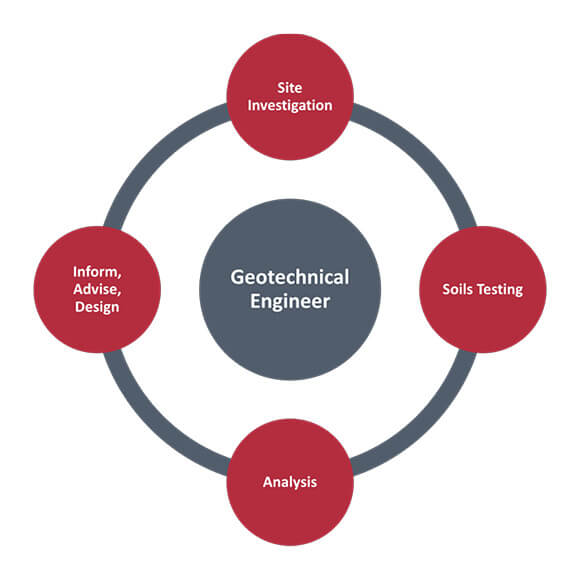Some Ideas on Geotheta You Need To Know
Some Ideas on Geotheta You Need To Know
Blog Article
Geotheta Can Be Fun For Anyone
Table of ContentsThe smart Trick of Geotheta That Nobody is DiscussingLittle Known Questions About Geotheta.The Basic Principles Of Geotheta 5 Simple Techniques For Geotheta
They collaborate with civil engineers, structural designers, architects, and other professionals to incorporate geotechnical considerations into the overall task layout and building process. This needs efficient synergy, coordination, and communication to make sure that the geotechnical elements straighten with the task objectives and fulfill regulatory needs.Mining & Products Design: Principles of drilling, penetration prices, and elements impacting the option of exploration method. Blasting methods in surface and underground operations. Mechanical and constant strategies to fragmentation, consisting of longwall shearing and fullface boring.
Modelling of piece and bit size circulations; comminution as a transfer feature. Comminution modern technology: crushing, grinding, dimension classification. Integrated evaluation of fragmentation and comminution procedures. Offered by: Mining & Materials Design.
The smart Trick of Geotheta That Nobody is Discussing
Bachelor's level programs in civil, geotechnical, geological, and environmental engineering normally last four years and include basic education and learning courses in English, social science, and the humanities, as well as courses in innovative mathematics, structural geology, and liquid mineralogy. (https://filesharingtalk.com/members/599923-geotheta)
Geotechnical engineering entails the assessment of the soil and rock problems at a particular site, and their ramifications for the growth of that site. As the majority of frameworks rely upon the ground for support, it is without surprise that a detailed understanding of the ground conditions, and the suitability of structure systems, are crucial to the long-lasting security and efficiency of the structure or structure.
Specialising in the investigation of geological formations and ground practices, geotechnical designers execute scientific investigations and testing to recognize the impact these geological formations might have on the design and building of structure, civil and infrastructure projects. This expertise is critical for the layout and building and construction of buildings, roadways, tunnels, dams, bridges, and water supply and sewer system.
The geotechnical team at Douglas Allies consistently seek advice from designers, style engineers, developers, and home builders to make recommendations on style and advancement propositions to ensure that the built frameworks are appropriately designed for the ground problems. As an example, the layout of footing systems requires to think about the weight of the structure, the capability of the ground to support that weight along with motion tolerances and reliable building.
7 Easy Facts About Geotheta Described
This job is substantially streamlined by the use our Douglas Map geospatial platform that makes this info easily available in a very easy to make use of web internet browser user interface. A geotechnical designer will guide the drilling of boreholes and test pits to collect soil and other samples, and additionally examine surface area functions and ground direct exposures to create a geotechnical model of the subsurface conditions.
Depending upon the project kind and ground conditions experienced, lab screening may amongst other things assess stamina, compressibility, reactivity and/or permeability of dirt and rock examples. Hereafter data is accumulated and collected, the outcomes are used for a geotechnical model of the website, which is normally presented as areas throughout the site.

A geotechnical investigation by nature can only evaluate the ground problems at the areas drilled or dug deep into. Natural variations in soil and rock problems can happen throughout a site and in between examination locations. It is for that reason good practice that the geotechnical designer be maintained throughout construction of the project to supply on-site verification that the ground conditions experienced are consistent with the assumptions and advice supplied in the geotechnical examination record.
The Ultimate Guide To Geotheta
Geotechnical designers utilize their extensive understanding of dirt and rock to assess threat and address troubles on varied infrastructure projectsGeotechnical design is a specialist branch of civil design which checks out the behaviour of planet materials and the application of dirt and rock auto mechanics. Geotechnical Engineers. As a geotechnical designer, you will assess the physical, mechanical and chemical properties of soil and rock in order to develop foundations, maintaining structures and earthworks
Geotechnical design is closely linked to and overlaps with, both design geology and ground design - https://profile.hatena.ne.jp/geotheta/. It's possible to specialise in geotechnics or help a geotechnical firm yet be called a design geologist or a ground designer. As a geotechnical engineer, you'll need to: develop and maintain partnerships with clients and various other professionals associated with the website, throughout each projectmaintain security standards on site bear in mind price effects when you make you could try this out recommendationsstudy geological maps and airborne pictures from a variety of resources and from various time periodsexamine building prepares to see how viable they are based upon your understanding of the siteinvestigate threats or geological hazards for the sitesearch for eco sensitive features, such as land fill beginning to develop factual and expository ground modelsplan field investigationsdrill and analyse examples of bedrock, dirt, groundwater and added materials oversee other experts on sitesolve technological concerns as they emerge, such as unforeseen structures at drill sitesmonitor problems during and after building and construction to make certain frameworks are steady in the brief and lengthy termadding data gathered on site to your initial researchcreating geotechnical calculations, illustrations, and 2 or three-dimensional computer versions interpreting the datamaking referrals regarding the recommended use the website

Report this page